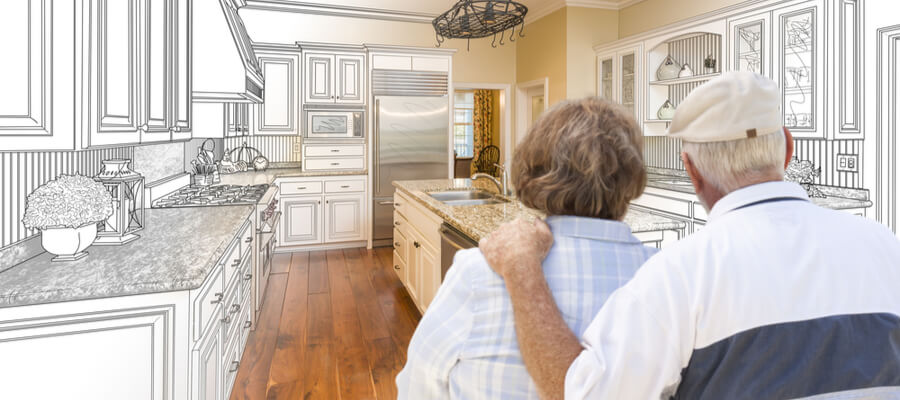There are plenty of reasons why people want to stay in their homes as they enter their retirement years. Familiarity with the neighbourhood, having friends and family close by and wanting to maintain their independence are all high on the list.
Aging at home often means having renovations carried out so that growing mobility needs are met. While it may cost thousands of dollars to pay for some of these renovations, when compared to the cost of living in assisted housing, it may seem like a bargain. In 2017, according to the Canadian Mortgage and Housing Corporation, the average annual rent for a standard seniors’ housing unit was $42,312 per year. This was across Canada, so people living in big cities may pay substantially more.
We’ve put together some home renovation tips to help you prepare your home for your growing needs, along with advice on finding contractors, applying for grants and borrowing money for renovations
Home Renovation Ideas to Help you Stay in your Home
While 86% of Canadian baby boomers prefer to age in place in the homes they love, not many plan for home renovations that simplify their lives during the golden years. It is not just about planning for a disability or mobility issue. It is about incorporating modern features and amenities that heighten accessibility and conveniences for all ages and make your day-to-day home living more enjoyable.
Adopting certain universal principles of design in your home improvement projects could lead to more benefits than you imagine. This includes:
- Designing the space to be useful for people with diverse abilities.
- Adding flexibility to the space through options for partitioning or opening up the rooms.
- Ensuring an intuitive design that enhances the look and simplifies the function of the space. For example, two-way light switches could help illuminate rooms that have multiple entry points.
- Incorporating visual or textural clues that ensure people with sensory issues can interact with the space effectively. This could be in the form of sensor-based, remote-controlled or digital access to various aspects of the space.
- Eliminating potential risks by making the space safe and efficient for use. For example, uniform flooring throughout the main floor to avoid transitions between different floor types.
- Minimizing the effort and movement while accomplishing the various tasks related to that space. You can achieve this by paying attention to the furniture placement, light sources, and other utilitarian aspects within the space.
In line with these principles of design, here are some useful home renovation ideas for Canadian 55 and over:
- Reposition electrical switches and outlets: Position your light switches at a height that does not require you to stretch your arms too high above your shoulders. Your grandkids will also be glad that they do not have to use step stools or stand on their tip toes just to switch a light on or off! The opposite is true for electrical outlets. Try to keep them high enough that you do not need to bend down to reach them. This will prevent potential trip or fall hazards by reducing the number of cords or wires on the floor.
- Make your life in the kitchen a breeze: If you are about to undertake a kitchen renovation or remodel, think about lowering the height of the countertops and cabinets so that able bodied family members, as well as those with any disabilities can use the space comfortably. Within the cabinetry, choose drawers over shelves, as they are easier to use and organize. Being able to get close enough to the prep areas can also add to your convenience while working in the kitchen. Hence, try to maintain a slight overhang for your countertops, just in case you or your spouse need a walker or become wheelchair-bound at any point. Remember to choose rounded edges for the countertops to avoid bumps and bruises during cooking and prepping.
- Plan for safer bathrooms: The bathroom is often the trickiest room in the house for people who develop mobility issues. Increasingly, people are choosing to have a new, accessible bathroom installed on their first floor, especially if they had no bathroom there before. However, if you are looking for home renovation ideas on a budget, just replace one bathroom shower with a curbless or walk-in version. Fold-down shower seats, raised toilets or grab bars are other home improvement options for people that require a minimal investment and can make your bathroom a safer place as you age.
- Focus on flooring: Uneven flooring is not only harder to navigate for those using walkers or wheelchairs, but it presents a trip or fall hazard even for those without any serious mobility or vision problems. One of the essential items on the home repairs lists for Canadians 55+ should be fixing and updating your flooring to eliminate any height changes, dips, odd transitions, or curbs. While addressing flooring issues, look at slip-resistant materials, such as textured tiles in bathrooms, or gentle-on-the-feet cork flooring for the rest of the rooms. If you prefer area rugs and carpets, be sure to have a non-slip rug pad underneath to prevent any slips, trips or falls.
- Plan features that enable single-level living: While aging does not necessarily mean walker dependent or wheelchair bound, many people may develop pain in the knees or hips, or feel physically exhausted while using stairs at home. Not everyone has the liberty or desire to move homes just because there are too many stairs in the current one. However, some carefully planned home renovations for aging in place could enable single-level living even in a multi-level home. This includes:
- Moving the laundry room to the main floor.
- Converting an existing guest room or unused formal dining room on the main floor into the primary bedroom.
- If space permits, then expanding the powder room into a 3-piece with a shower stall.
Other home renovations for aging in place that will make living at home a lot easier are:
- Expanding the width of doorways
- Installing ramps for entranceways
- Adding stair lifts or home elevators
- Having threshold-free doorways
- Switching to lever handles for all your interior doors for better grip while entering or exiting the rooms.
For households with seniors 65 and over, many home renovation projects may qualify for government grants and programs. While each province runs their own support initiatives for home adaptations or home modifications for low income Canadian seniors, there are grants available for emergency home repairs, as well as for building secondary suites as an additional source of income.
Finding a suitable home renovation contractor
While undertaking home improvements to successfully age in place, it is important to work with builders who have experience with mobility related renovations. Good contractors experienced in this field will work with your therapist to make improvements that function for everyone living in the home. They also know which grants are available and will help you access them.
The National Association of Home Builders is a great resource for finding certified, aging-in-place specialists (CAPS). Alternatively, you can search online for “aging in place renovations” and include the name of your city.
Softening the financial burden with home renovation grants
There are provincial and municipal grants available across Canada to help pay for a variety of renovation needs.
For renovations specifically geared towards improving your home’s accessibility, programs like the BC Rebate for Accessible Home Adaptations (BC RAHA) in BC and Nova Scotia’s Home Adaption for Seniors’ Independence program provide financial help. They offer grants or forgivable loans (whereby you don’t have to repay the loan if you stay in the home for over six months) of between $3,500 – $20,000.
The Toronto Renovates program for seniors also provides up to $15,000 in forgivable loans to cover essential repairs like heating, plumbing and electrical.
Search online for “renovation rebates” and include the name of your province.
Borrowing money for home renovations
Even with grants or provincial loans, you may need a considerable sum of money to adequately renovate your home for your needs.
If you’re a homeowner aged 55-plus, a CHIP Reverse Mortgage® from HomeEquity Bank is a great option to provide you with the funds you need. You can borrow up to 55% of your home’s appraised value and never have to make any regular mortgage payments. You only pay what you owe when you move out or sell your home.
Find out how the CHIP Reverse Mortgage® could provide the funding for the renovations you need. Call us at 1-866-522-2447 to find out how much tax-free cash you qualify for. You can also use our reverse mortgage calculator to get a quick estimate of how much tax-free cash is available to you.































